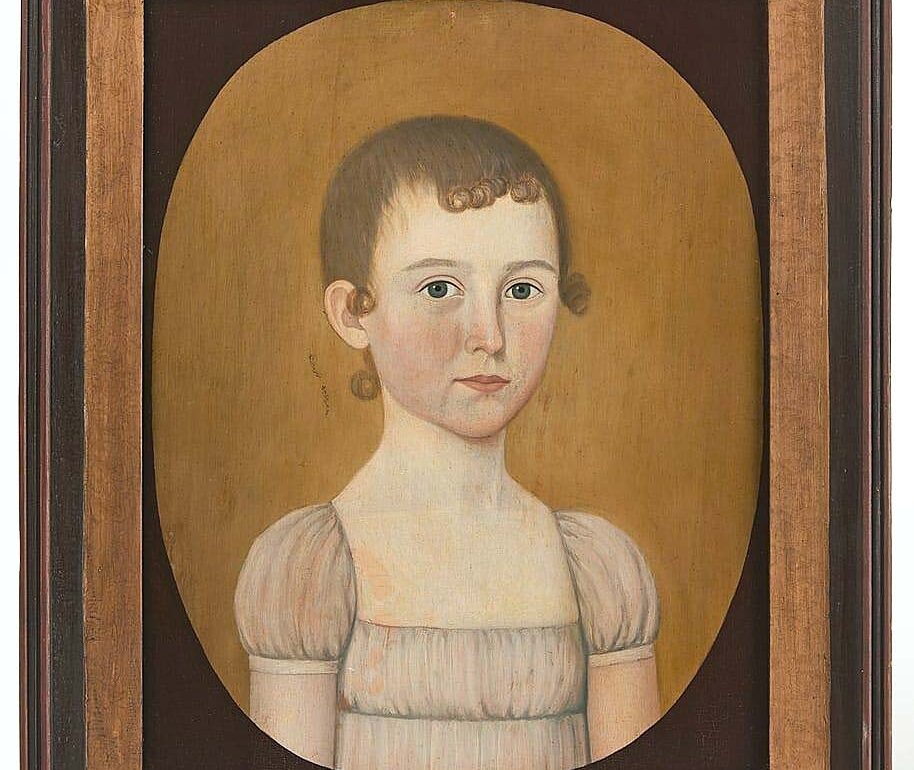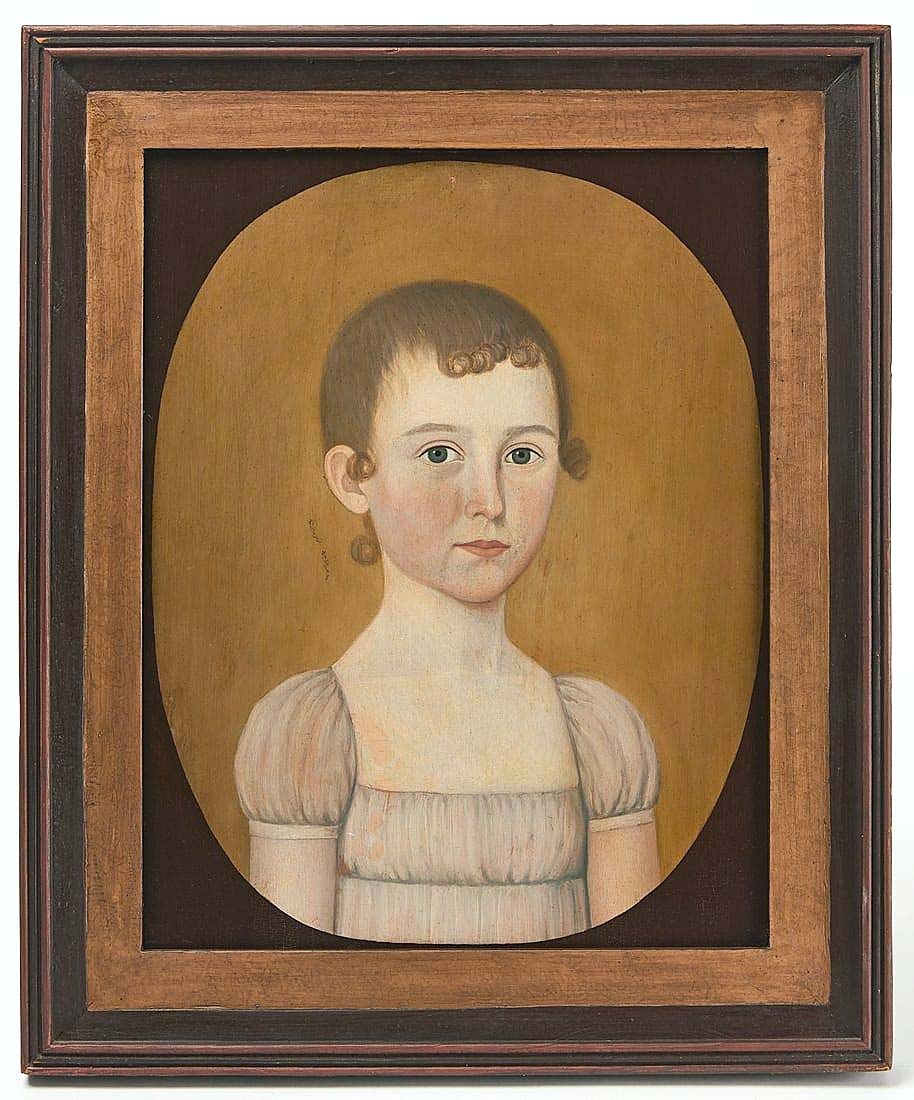
The star of the sale was John Brewster’s portrait of a young girl in a white dress. Painted on board, an uncommon medium for Brewster, it sold for $150,000, nearly five times the estimate.
Review & Onsite Photos by Rick Russack
BRANFORD, CONN. — Fred Giampietro’s New England Auctions’ January 10-11 sale included fine art from a collection that has been off the market for decades, American furniture and clocks, more than 40 samplers, a selection of works by outsider artists, Native American materials, contemporary Frank Finney carvings, several weathervanes from the collection of Ron and Penny Dionne, redware, stoneware and some exceptional folk art.
The sale netted $2.5 million, the highest figure the house has achieved thus far. One indication of the overall strength of the sale was the fact that 29 items earned prices in excess of $10,000 and only four items of the more than 900 lots did not sell. More than 1,000 bidders were on the Liveauctioneers website, watching the sale on each day of the sale, suggesting a strong market.
Day one was a feast for folk art lovers and included a bird tree with 70 birds that would probably top any example you’ve seen. The highlight of the day — and the highlight of the two-day sale — was a portrait on a wood panel of a young girl in a white dress by John Brewster (1766-1854). It had provenance to Christie’s and sold for $150,000, nearly five times the estimate. The day after the sale, folk art dealer David Schorsch, who did not buy it, commented that “it was an unusual example of Brewster’s work. Few Brewsters are on wood panels; I’ve seen many Brewsters but not on wood and the use of spandrels was also uncommon for Brewster. I was really pleased to see it bring the price it did. It’s great for the market.”
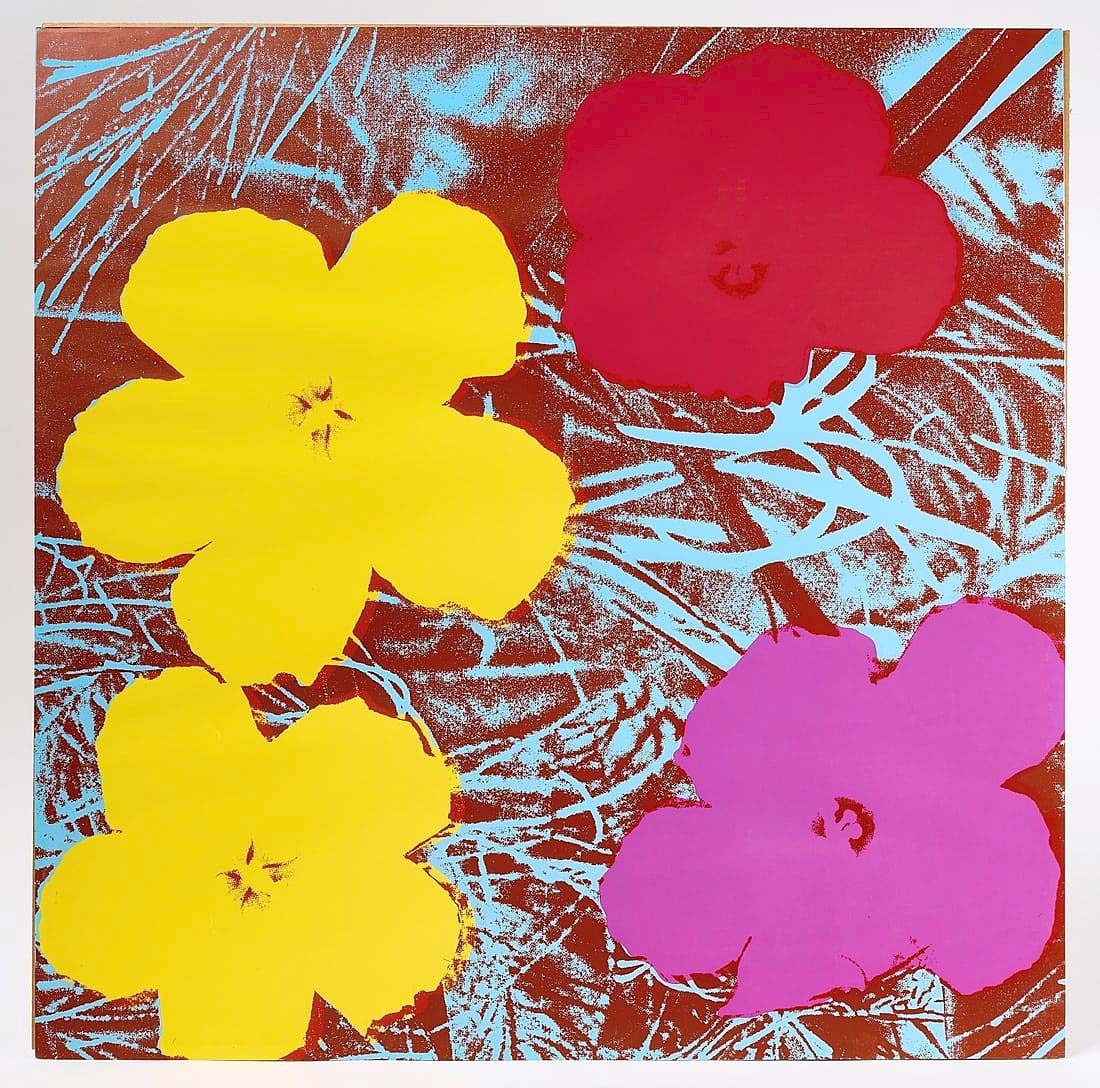
The top lot of the second day, earning $68,750, was an Andy Warhol color print, signed and numbered 37/250. It was from his “Flower” portfolio of 10 prints.
Day two of the sale included fine art, silver, jewelry and watches, Oriental carpets, as well as Midcentury Modern furniture and accessories. The top lot of the day was a color screen print, F71, from Andy Warhol’s 1970 “Flower” portfolio which consisted of 10 prints; this one was signed and numbered 37/250 and sold for $68,750.
When appropriate, to increase bidder confidence as to condition, New England Auctions often includes photos taken under ultraviolet light with their internet descriptions. Provenance for many of the pieces was known and included names such as Nina Fletcher Little, Peter Brams, Olde Hope Antiques, Fred Giampietro and other well-known collectors and dealers.
Does presale interest indicate relative strengths of different segments of the market? Liveauctioneers provides some thought-provoking presale statistics. For example, a couple of days before the sale, those statistics showed that of the several lots of furniture, an Eames lounge chair had 130 bidders watching it while a Chapin-school Connecticut highboy had 36. A Louis Vuitton steamer trunk was being watched by 87 bidders and a set of four bamboo turned, painted Windsor chairs was being watched by 16 potential bidders.
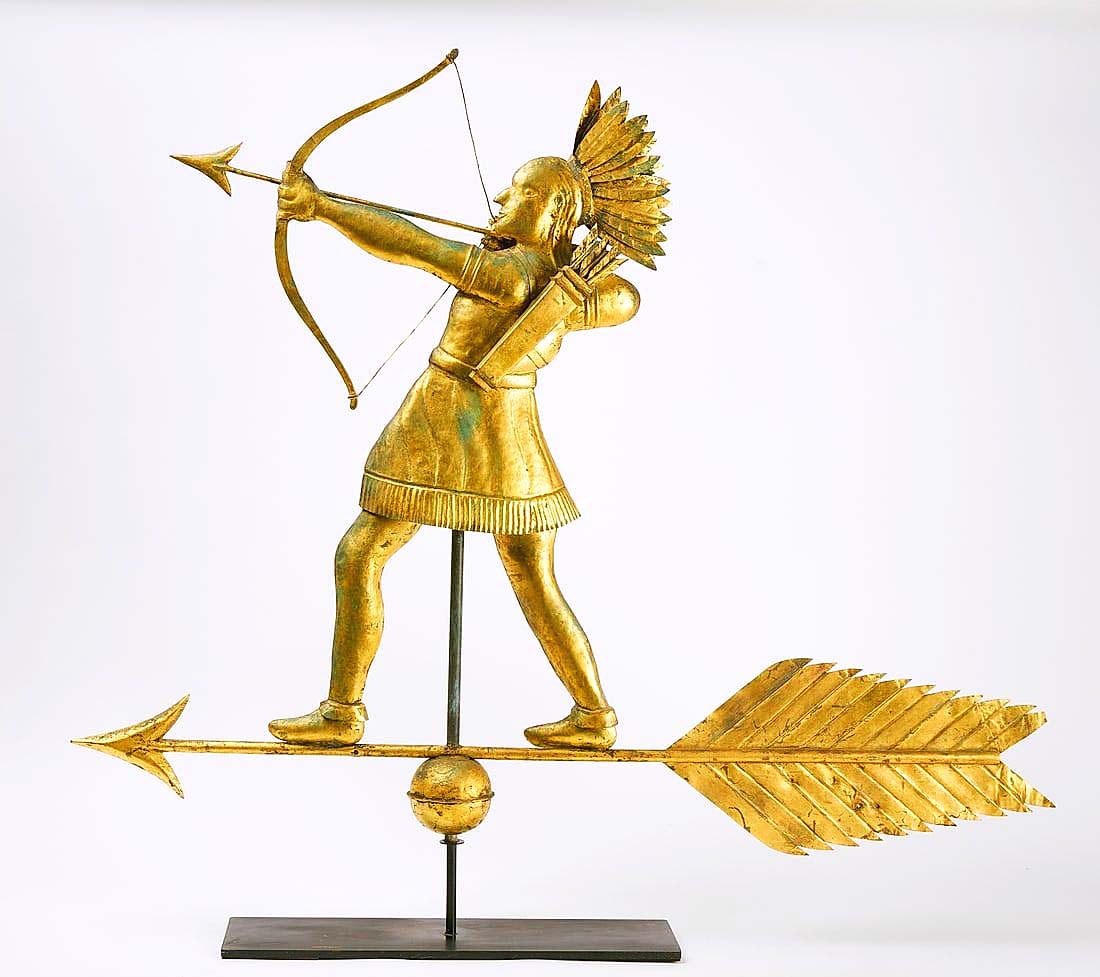
At 43 inches tall, this Native American archer weathervane was the star of that category. Attributed to the J.L. Mott Iron Works, it was in fine condition with a gilded surface and earned $68,750.
Weathervanes from the Dionne collection were one of the features of the first day. Until their retirement 10 years ago, Ron and Penny Dionne were active folk art dealers and collectors and they’ve continued to collect. After the sale, Penny Dionne commented, “This was the first time we sold a group of items from our personal collections. We picked out 23 items and it wasn’t easy. Weathervanes have always been our favorite things, but Ron and I agreed that it was time to let some go. We especially liked those in the form of animals, and, I think, horses were our most favorite. It was a pleasure working with Fred and everything went smoothly.”
Most valuable of the weathervanes was a large copper Native American archer. It stood 43 inches tall and 48 inches wide with a gilded surface. Attributed to the J.L. Mott Iron Works, it sold for $68,750, tying with the Warhol mentioned above for the sale’s second highest price. Among the most sought-after was a rare Centaur weathervane that measured more than 40 inches wide. It was made by the A.L. Jewell Company and was constructed of molded copper, zinc and lead. It had an old surface with repaired bullet holes, and it brought $35,000. An 18-inch copper squirrel, attributed to L.W. Cushing, brought $8,750.
Outsider art got the sale underway with five works by Eddie Arning (1898-1993). Leading the group was a cray-pas on paper piece titled “Three Ladies.” According to the Smithsonian’s artist website, Arning was institutionalized for most of his adult life and was introduced to drawing in 1964 by a hospital worker who supplied him with materials. Arning’s medium from 1964 to 1969 was Crayola crayons. In 1969, he switched to oil pastels, or “Cray-pas” and finished his artistic career in 1974 when he was released from the hospital. “Three Ladies” sold for $2,375. A church scene by Clementine Hunter (1887-1988) made $5,500. Three unsigned carved figures by Edgar Tolson (1904-1984), the tallest of which was a little over 26 inches, sold for $5,250. There were several other outsider pieces to choose from. A carved marble sundial plaque, by known but unidentified carver HD, sold for $6,875. It was signed and dated 1927 and is the earliest known work by this outsider artist.
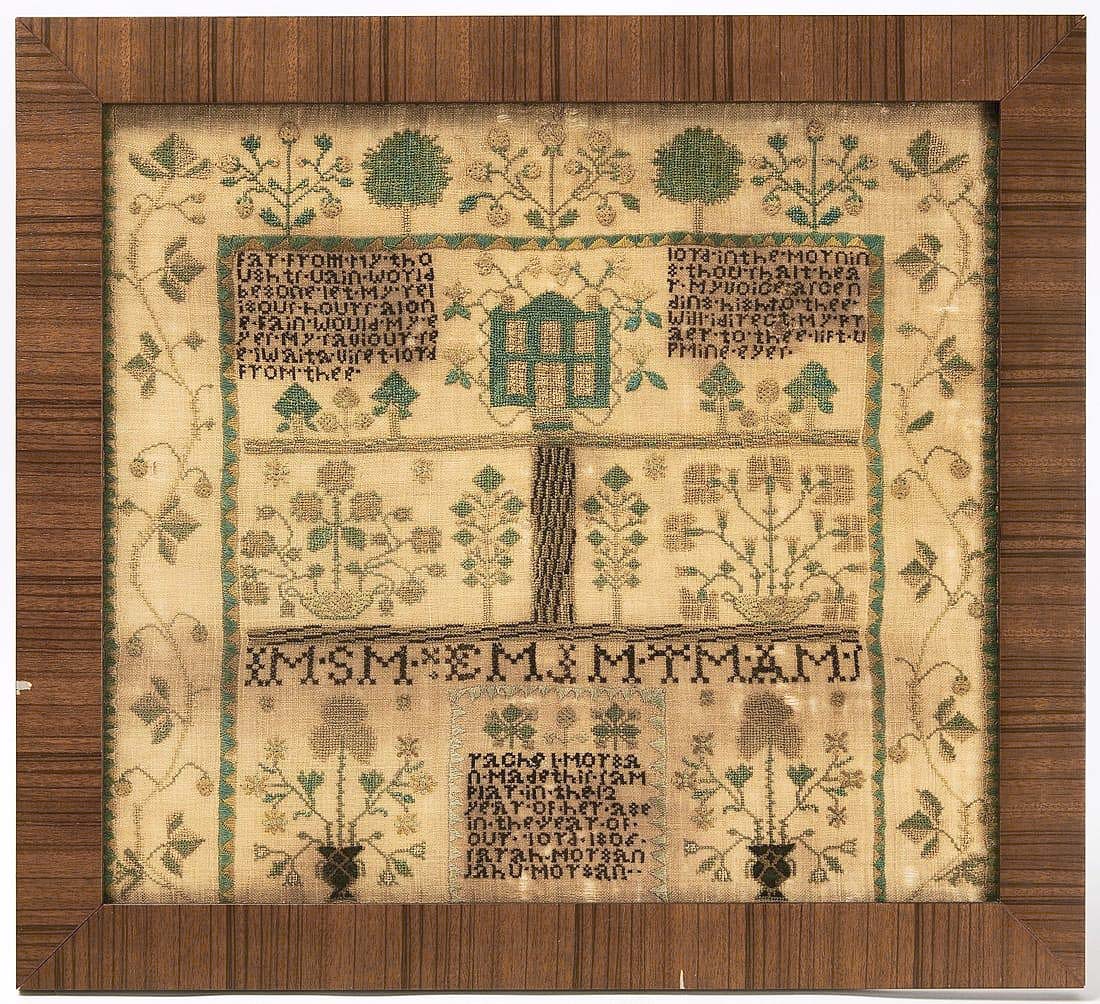
The sale included about 40 samplers, many from the collection of Ann Fassnacht and several Southern examples. This 1806 example by 12-year-old Rachel Morgan, Monongalia County, W.Va., earned $45,000, far exceeding the estimate, and it was the highest price of the collection.
Many of the more than 40 samplers in the sale were from the collection of Ann Fassnacht, who is now in her 90s. Giampietro said, “Genealogy was important to her, and she did a lot of research for the things in her collection. Most of the samplers were accompanied by folders of her research.” Southern examples did well with the top price of the selection, $45,000, earned by an 1806 example by 12-year-old Rachel Morgan of Monongalia County, W.Va.; her father was Morgantown founder, Zacquill Morgan. The sampler depicts a two-story brick home surrounded by a strawberry and vine border, with moral sayings on each side of the house. Included with the sampler were 10 folders of mostly genealogical information. A sampler made in 1798 by 8-year-old Eizabeth Waller in Williamsburg, Va., earned $5,750 and was bought by Colonial Williamsburg. With a border of strawberry vines, the center depicted two large birds facing each other, two teapots and a basket of flowers.
Other examples were made in New Jersey, Pennsylvania, Ohio and Baltimore. One made in Boston by 9-year-old Emma Powers earned $1,750. It included a three-story house, a 12-line religious poem and more.
In addition to the Brewster portrait, other folk paintings also did well. A portrait of a child in a pink dress with pink ribbons in her hair, by William Matthew Prior, which had been included in a 2001 exhibition at Boston’s Museum of Fine Arts, sold to David Schorsch for $32,500. A late Eighteenth Century portrait of a woman with flowers in her hair, by Joseph Stewart, sold for $15,000, as did “Emblem of Peace” an 1823 watercolor, previously in the Nina Fletcher Little collection.
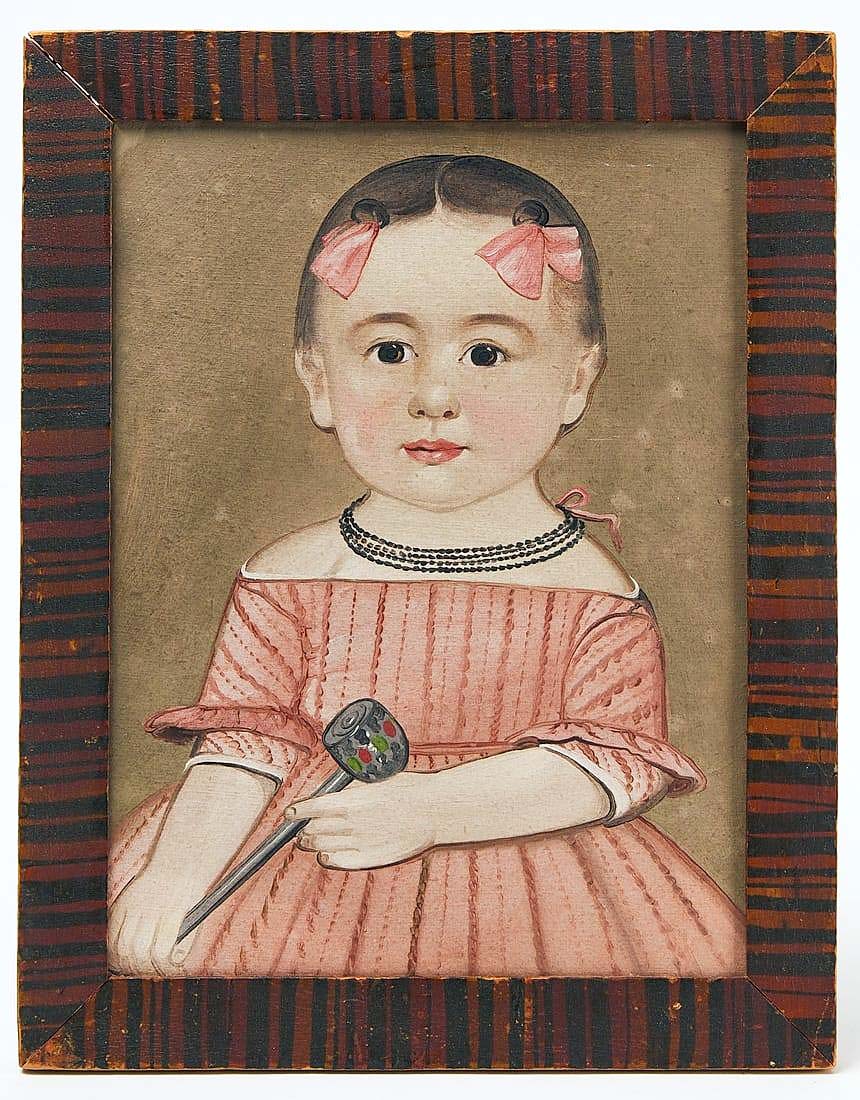
Exhibited at the Museum of Fine Arts, Boston, in 2001, this Prior-Hamblin school portrait of a child in a pink dress, painted in Maine circa 1840, was purchased by David Schorsch for $32,500.
Works by contemporary carvers included a very large swordfish by Colin McNair, a second-generation member of the McNair family of carvers, which sold for $3,250. Fifteen works by Frank Finney (b 1947) featuring some less common works, included a cat and mouse gameboard which sold for $4,500. His carvings ranged in price from $813 for a songbird to a Baltimore Oriole, almost 10 inches tall, which brought $3,500.
Fine art dominated the second day of the sale. As previously mentioned, the Warhol print brought the highest price as seven of the day’s eight top lots fell into the fine art category. An “Orientalist” oil on canvas courtyard scene by Edwin Lord Weeks (1849-1903) achieved $62,500. Weeks may have been the first American artist to visit India and many of his paintings were painted there. This scene is quite similar to one on view at the Metropolitan Museum of Art, described as “depicting preparations for a hunting expedition at a palace in Ajmer, Rajasthan. Likely dating from the artist’s 1892-93 trip to the country, he described the palace façade in his published accounts as completely covered by tiers of projecting windows…wonderfully light and airy in effect.” Bringing $52,500 was “Venetian Scene,” an oil on canvas depicting gondolas and figures at quays in various pursuits and watching the entry of a vessel to the Doges Palace. It was painted by French painter Felix François Georges Philibert Ziem (1821-1911).
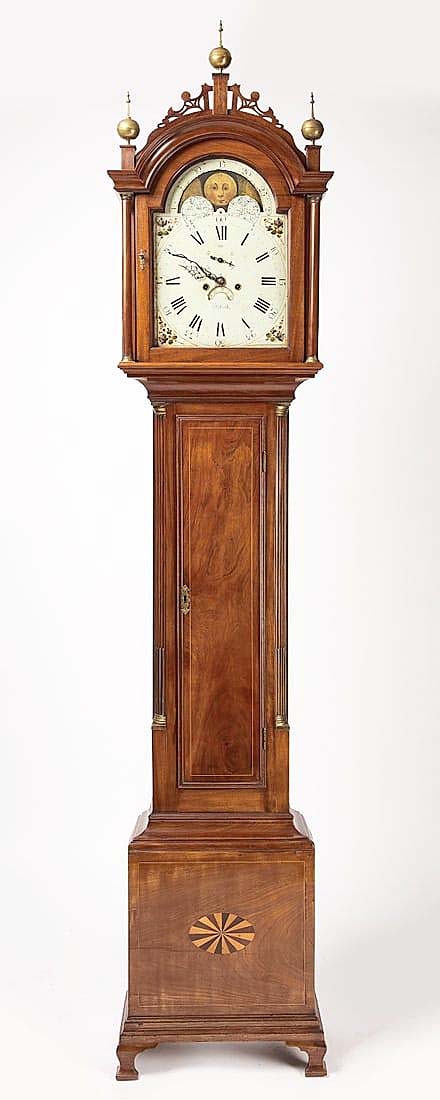
The bonnet fretwork and brass finials are original on this Simon Willard tall case clock. With a painted iron dial and a seconds movement, it brought $30,000.
Topping the selection of American furniture was a Simon Willard Roxbury mahogany tall case clock with fluted hood columns, a seconds pendulum and an iron painted dial likely by John Minnott. It retained its original brass finials and fretwork. It had belonged to dealer Gary Sullivan and it sold for $30,000. Achieving $9,375 was an early, circa 1765 walnut Connecticut Queen Anne highboy with a secret drawer in the bolection molded top; it retained an undisturbed deep original finish.
Painted furniture included an exceptional circa 1825 Soap Hollow cupboard with the original surface. It was signed “Stahl” and made $15,000. A circa 1825 Chester County, Penn., paint-decorated blanket chest with a horse, flora and the initials LP and MN, on an elaborate carved bracket base, earned $11,875. Probably from Maine, circa 1830-50, a large paint-decorated desk realized $6,875.
Ceramics in the sale ranged from early redware and stoneware to Southern face jugs and Picasso pottery. Two face jugs, sold together, one by Lanier Meaders, brought $1,500. The redware selection included several slip-decorated pieces. One of these, a 13-inch charger made about 1820 in Norwalk, Conn., inscribed “Lafayette” earned $10,625. A loaf dish, dated to about 1829, also inscribed “Lafayette” and from Norwalk, brought $9,375. From an edition of 500, a Picasso designed 5½-inch pitcher signed on bottom “Edition Picasso Madoura” earned $5,250.
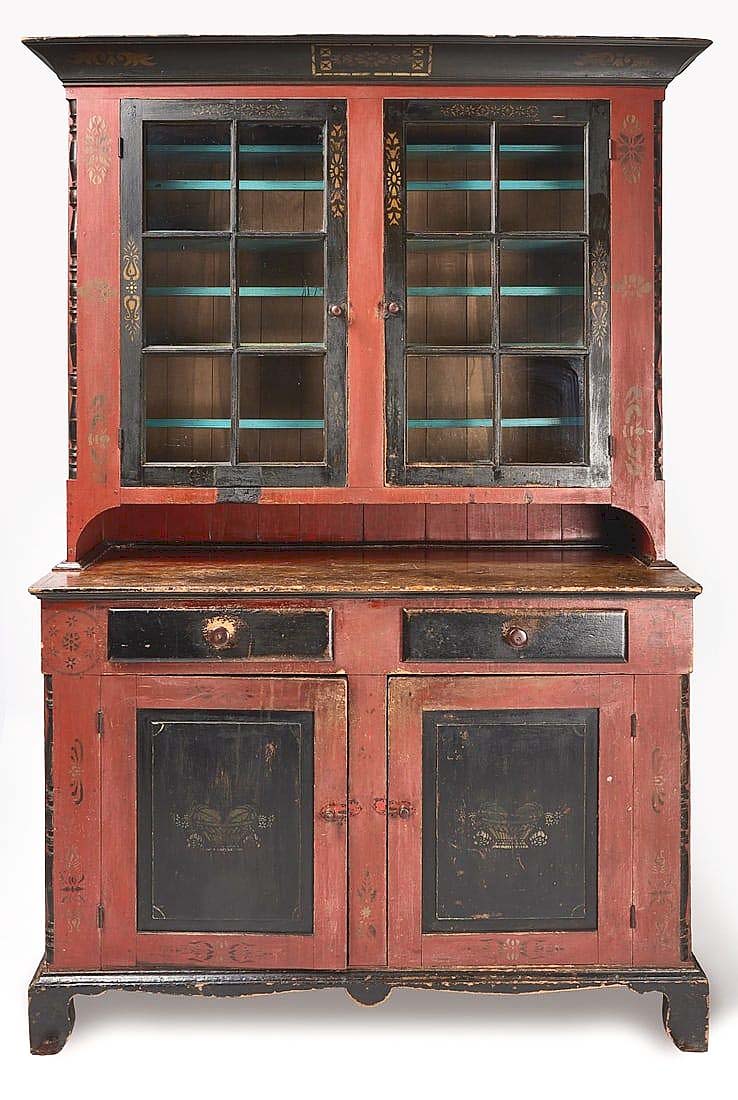
Signed “Stahl” for Jeremiah Stahl, this painted Soap Hollow cupboard reached $15,000. The catalog dated it to 1825.
A few days after the sale, Fred Giampietro said, “It really was a strong sale, in fact it was the highest total we’ve ever done. I think that’s due to our marketing which utilizes a variety of different vehicles and the lessons I learned from operating the contemporary gallery that I did. We promote heavily in Europe and Asia and a number of items went that way. It also helps us attract new, younger buyers. When putting together a sale I want to have a variety of items and I also want to have items that tie together. That works.”
Prices quoted include the buyer’s premium as reported by the auction house. For additional information, 475-234-5120 or www.newenglandauctions.com.
This post was originally published on this site be sure to check out more of their content



